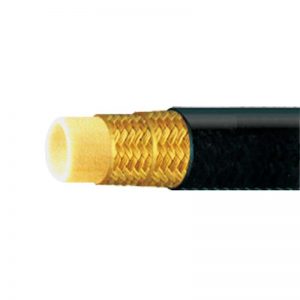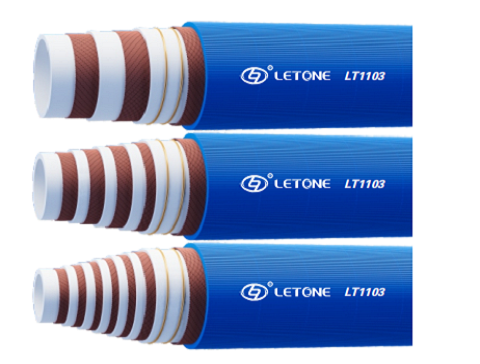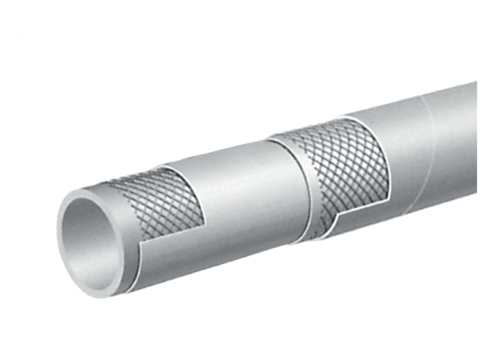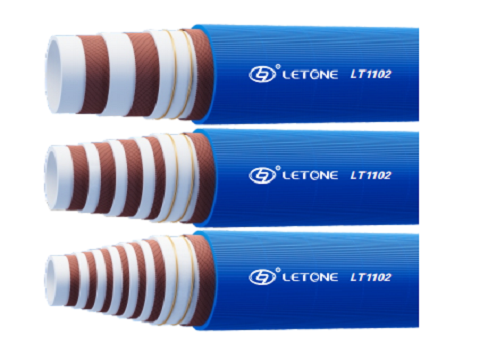On the vast and boundless path of energy exploration, high-pressure drilling hoses and oil drilling hoses play an indispensable role as the "lifeline" connecting the surface and underground treasures. They are not only a key component of modern oil extraction technology, but also a witness to the deep integration of human intelligence and natural resources. This article will deeply analyze the technical secrets of high-pressure drilling hoses and oil drilling hoses from the aspects of material science, design principles, technical applications, challenges faced, and future development trends.
 Innovation in Materials Science
The core competitiveness of high-pressure drilling hoses and petroleum drilling hoses lies in their material selection and innovation. These special pipelines need to withstand extreme working environments, including high temperature, high pressure, corrosive media, and frequent bending and stretching. Therefore, the selection of materials is crucial.
Modern high-pressure drilling hoses often use high-strength synthetic fibers as reinforcement layers, such as aramid fibers or polyester fibers, which not only have excellent tensile strength and fatigue resistance, but also effectively resist chemical corrosion. The inner and outer rubber layers are usually made of synthetic rubber materials that are oil resistant, wear-resistant, and heat-resistant, such as nitrile rubber (NBR), hydrogenated nitrile rubber (HNBR), or fluororubber (FKM), to ensure the sealing and durability of the hose under harsh working conditions.
The Precision of Design Principles
The design of high-pressure drilling hoses and oil drilling hoses fully considers the principles of engineering mechanics, and achieves a perfect combination of high pressure bearing capacity and good flexibility through optimized structural layout and enhanced layer configuration. Hoses are typically composed of multiple layers, including an inner adhesive layer, a reinforcement layer, an outer adhesive layer, and possibly a protective layer, each layer carrying a specific function.
The design of the reinforcement layer is particularly crucial, as it determines the pressure bearing capacity and explosion resistance of the hose. By accurately calculating and reasonably arranging the arrangement of fiber or steel wires, the radial and axial strength of the hose can be significantly improved, while maintaining sufficient flexibility to adapt to complex drilling trajectories. In addition, the design of the joint is also one of the technical difficulties. High quality joints can ensure that the hose does not leak under high pressure, and the connection is stable and reliable.
Wide application of technology
High pressure drilling hoses and petroleum drilling hoses are widely used in fields such as petroleum, natural gas, geothermal, mineral resource exploration, and deep well construction. In oil drilling, they not only undertake important tasks such as transporting drilling fluid, controlling well pressure, and transmitting power, but also serve as key tools for implementing complex drilling processes such as directional drilling and horizontal drilling.
With the rise of offshore oil development, these hoses have become the "blood vessels" of deep-sea drilling, connecting offshore drilling platforms with oil wells at the bottom of the deep sea. In extreme sea conditions and deep-sea environments, high-pressure drilling hoses and oil drilling hoses have demonstrated excellent adaptability and stability, providing strong support for the development of marine energy.
Challenges and Responses Faced
Despite significant technological advancements in high-pressure drilling hoses and oil drilling hoses, they still face many challenges. With the continuous increase of drilling depth and the increasingly complex drilling environment, the requirements for hose materials, structures, and performance are also becoming higher and higher.
Firstly, how to further improve the pressure bearing capacity and corrosion resistance of hoses to adapt to deeper and more harsh drilling environments is one of the current research hotspots. Secondly, how to reduce the production cost of hoses, improve production efficiency, and meet the needs of large-scale exploration and development is also an urgent problem that needs to be solved. In addition, with the increasing awareness of environmental protection, how to reduce environmental pollution during the production and use of hoses and achieve green drilling is also an important direction for the development of the industry.
In response to these challenges, researchers and enterprises are constantly exploring new materials, processes, and technologies. For example, developing new high-strength and highly corrosion-resistant composite materials, optimizing hose structure design to reduce material usage and weight, adopting environmentally friendly production processes to reduce waste emissions, etc.
Future Development Trends
Looking ahead to the future, the development of high-pressure drilling hoses and oil drilling hoses will present the following trends:
1. Material innovation: Continue to promote the research and application of new materials, such as nanomaterials, biobased materials, etc., to improve the performance and environmental friendliness of hoses.
2. Intelligent development: Utilizing modern information technologies such as the Internet of Things and big data to achieve remote monitoring, fault diagnosis, and intelligent maintenance of hoses, improving the safety and efficiency of drilling operations.
3. Lightweight design: By optimizing structural design and using lightweight and high-strength materials, the weight of hoses can be reduced, and transportation and installation costs can be lowered.
4. Environmental Protection and Sustainable Development: Strengthen the research and development of environmental protection technologies, reduce environmental pollution during production and use, and promote the transformation of the industry towards green, low-carbon, and sustainable development.
In short, high-pressure drilling hoses and oil drilling hoses are important equipment in the field of petroleum exploration and development. Their technological progress and innovative development are of great significance for ensuring national energy security and promoting economic and social development. Faced with future challenges and opportunities, we have reason to believe that this field will continue to see new breakthroughs and leaps.
Innovation in Materials Science
The core competitiveness of high-pressure drilling hoses and petroleum drilling hoses lies in their material selection and innovation. These special pipelines need to withstand extreme working environments, including high temperature, high pressure, corrosive media, and frequent bending and stretching. Therefore, the selection of materials is crucial.
Modern high-pressure drilling hoses often use high-strength synthetic fibers as reinforcement layers, such as aramid fibers or polyester fibers, which not only have excellent tensile strength and fatigue resistance, but also effectively resist chemical corrosion. The inner and outer rubber layers are usually made of synthetic rubber materials that are oil resistant, wear-resistant, and heat-resistant, such as nitrile rubber (NBR), hydrogenated nitrile rubber (HNBR), or fluororubber (FKM), to ensure the sealing and durability of the hose under harsh working conditions.
The Precision of Design Principles
The design of high-pressure drilling hoses and oil drilling hoses fully considers the principles of engineering mechanics, and achieves a perfect combination of high pressure bearing capacity and good flexibility through optimized structural layout and enhanced layer configuration. Hoses are typically composed of multiple layers, including an inner adhesive layer, a reinforcement layer, an outer adhesive layer, and possibly a protective layer, each layer carrying a specific function.
The design of the reinforcement layer is particularly crucial, as it determines the pressure bearing capacity and explosion resistance of the hose. By accurately calculating and reasonably arranging the arrangement of fiber or steel wires, the radial and axial strength of the hose can be significantly improved, while maintaining sufficient flexibility to adapt to complex drilling trajectories. In addition, the design of the joint is also one of the technical difficulties. High quality joints can ensure that the hose does not leak under high pressure, and the connection is stable and reliable.
Wide application of technology
High pressure drilling hoses and petroleum drilling hoses are widely used in fields such as petroleum, natural gas, geothermal, mineral resource exploration, and deep well construction. In oil drilling, they not only undertake important tasks such as transporting drilling fluid, controlling well pressure, and transmitting power, but also serve as key tools for implementing complex drilling processes such as directional drilling and horizontal drilling.
With the rise of offshore oil development, these hoses have become the "blood vessels" of deep-sea drilling, connecting offshore drilling platforms with oil wells at the bottom of the deep sea. In extreme sea conditions and deep-sea environments, high-pressure drilling hoses and oil drilling hoses have demonstrated excellent adaptability and stability, providing strong support for the development of marine energy.
Challenges and Responses Faced
Despite significant technological advancements in high-pressure drilling hoses and oil drilling hoses, they still face many challenges. With the continuous increase of drilling depth and the increasingly complex drilling environment, the requirements for hose materials, structures, and performance are also becoming higher and higher.
Firstly, how to further improve the pressure bearing capacity and corrosion resistance of hoses to adapt to deeper and more harsh drilling environments is one of the current research hotspots. Secondly, how to reduce the production cost of hoses, improve production efficiency, and meet the needs of large-scale exploration and development is also an urgent problem that needs to be solved. In addition, with the increasing awareness of environmental protection, how to reduce environmental pollution during the production and use of hoses and achieve green drilling is also an important direction for the development of the industry.
In response to these challenges, researchers and enterprises are constantly exploring new materials, processes, and technologies. For example, developing new high-strength and highly corrosion-resistant composite materials, optimizing hose structure design to reduce material usage and weight, adopting environmentally friendly production processes to reduce waste emissions, etc.
Future Development Trends
Looking ahead to the future, the development of high-pressure drilling hoses and oil drilling hoses will present the following trends:
1. Material innovation: Continue to promote the research and application of new materials, such as nanomaterials, biobased materials, etc., to improve the performance and environmental friendliness of hoses.
2. Intelligent development: Utilizing modern information technologies such as the Internet of Things and big data to achieve remote monitoring, fault diagnosis, and intelligent maintenance of hoses, improving the safety and efficiency of drilling operations.
3. Lightweight design: By optimizing structural design and using lightweight and high-strength materials, the weight of hoses can be reduced, and transportation and installation costs can be lowered.
4. Environmental Protection and Sustainable Development: Strengthen the research and development of environmental protection technologies, reduce environmental pollution during production and use, and promote the transformation of the industry towards green, low-carbon, and sustainable development.
In short, high-pressure drilling hoses and oil drilling hoses are important equipment in the field of petroleum exploration and development. Their technological progress and innovative development are of great significance for ensuring national energy security and promoting economic and social development. Faced with future challenges and opportunities, we have reason to believe that this field will continue to see new breakthroughs and leaps.







